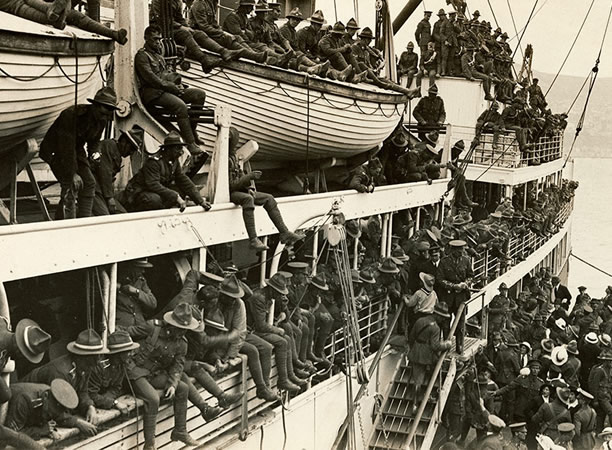
This article provides an overview of how the New Zealand forces were organised during the First World War. It explains how and when military units were created and how their formation changed over the course of the war.
The structure of British Units
The New Zealand Expeditionary Force (NZEF) formed part of the British military forces during the First World War, and served where and how the British authorities determined. The British forces included units from the United Kingdom and from British possessions and dominions such as India, Canada, Australia and New Zealand. These disparate forces were trained and organised on the same lines, so they could fit together seamlessly as a larger organisation.
The basic unit of the British forces was the division. Its exact composition varied considerably over the course of the war, but it usually consisted of around 20,000 men. The British started the war with only six divisions, but by the end of the war they had more than 60.
Each division comprised a variety of complementary units which together formed a miniature army. Divisions were the building blocks of wider structures which could be assembled and disassembled as required.
New Zealand’s forces served in several different divisions at different times. At the beginning of the war divisions typically included infantry battalions, mounted rifles regiments and artillery batteries; specialist units such as engineers, medics, and signallers; and support and supply units. Divisions were in constant evolution as the war progressed, their composition changing in response to battlefield conditions and combat strategies.
A group of several divisions (usually three) was known as a corps (pronounced ‘core’), and a group of corps was known as an army. By the end of the war, the British had five armies positioned alongside each other on the Western Front. The high command planned giant offensives which envisaged several armies advancing simultaneously, hopefully pushing the enemy back all along the line.
The British authorities divided British and imperial troops into groups named for the theatre of war in which they operated. The troops on the Western Front formed the British Expeditionary Force, those on Gallipoli the Mediterranean Expeditionary Force, and those in Sinai and Palestine the Egyptian Expeditionary Force.
Creation of the NZEF
On the outbreak of war in August 1914, the New Zealand government offered an expeditionary force to the British to serve as part of their army. The British authorities accepted, and New Zealand set to work recruiting men.
NZEF Units
Infantry
Mounted Rifles
Auckland Mounted Rifles Regiment
Canterbury Mounted Rifles Regiment
Wellington Mounted Rifles Regiment
Artillery
New Zealand Field Artillery Brigades
Specialist units
Medical units
New Zealand Army Nursing Service
Supply and administrative units
Māori and Pacific units
In 1914 Britain had a very small standing army, unlike the major combatant countries in mainland Europe. It had formerly relied upon the strength of the Royal Navy, assuming that any major conflict in which it participated would be decided at sea.
Britain’s growing concern about a possible war in Europe had prompted the development of new defence plans in the decade before the war. These plans included urging the British dominions – particularly Canada, Australia, and New Zealand – to reorganise their volunteer forces in preparation for war.
The dominion forces would be organised as territorial armies, nominally designed to protect their homelands from attack but really intended to create a pool of trained men who might one day form the basis of an expeditionary force. Each dominion force would mirror the units of the British forces, and training would utilise British manuals and methods. Weapons and equipment would also be standardised.
The scheme largely succeeded, with the dominion forces able to slot into the larger British force without major difficulty when war came. New Zealand’s Territorial Force, in which service was compulsory, formed the basis of the New Zealand Expeditionary Force (NZEF), a new voluntary force created for the duration of the war.
There was no formal connection between the Territorials and the NZEF. Nevertheless, the NZEF reproduced the structure and techniques of the Territorials, and many of those who volunteered had received relevant military training in the territorials.
The Territorial scheme operated within the four military districts of Auckland, Wellington, Canterbury, and Otago, each of which maintained a quarter of the overall force. The government used the same structure to underpin the infantry and mounted rifles in the NZEF, with each military district expected to find a quarter of the volunteers.
Each district supplied an infantry battalion and a mounted rifles regiment to the NZEF, known as the ‘Auckland Battalion’, the ‘Canterbury Mounted Rifles Regiment’, and so on. Each regional unit comprised three or four smaller units, each based on a local Territorial Force unit. The Auckland Mounted Rifles Regiment, for instance, consisted of the 3rd (Auckland) Squadron, the 4th (Waikato) Squadron and the 11th (North Auckland) Squadron.
The NZEF also included a field artillery brigade and specialist units such as signallers, engineers, medics and a few smaller sections, all of which were national units not divided into regional sections. The initial force of 7761 men left New Zealand – along with 738 reinforcements – in October 1914.
Gallipoli, 1914-16
In 1914 the NZEF sailed with Australian forces to Egypt, where their units trained together. The NZEF was too small to form its own division, so it was combined with an Australian mounted rifles brigade and infantry brigade to form the New Zealand and Australian Division. This and the 1 Australian Division comprised the Australian and New Zealand Army Corps (ANZAC), which served on Gallipoli in 1915 as part of the Mediterranean Expeditionary Force (which included other British Empire and French troops).
The pressures of the Gallipoli campaign prompted the New Zealand authorities to expand the NZEF, adding a second artillery brigade, a second infantry brigade (the New Zealand Rifle Brigade), and various specialist, support and medical units. By February 1916 the new units had almost doubled the size of the NZEF to 14,338 men.
In December 1914, the NZEF established the New Zealand Base Depot at Zeitoun Camp, Cairo, where training was conducted and reinforcements housed. The 1st New Zealand Stationary Hospital was based initially at Port Said before shifting during the Gallipoli campaign to Salonika in Greece, where it remained until March 1916. The 2nd New Zealand Stationary Hospital treated Gallipoli casualties at Pont de Koubbeh, Cairo, from July 1915. The Lady Godley Convalescent Home served recovering New Zealand servicemen in Egypt from March 1915, and the Aotea Convalescent Home opened at Heliopolis, near Cairo, in October 1915.
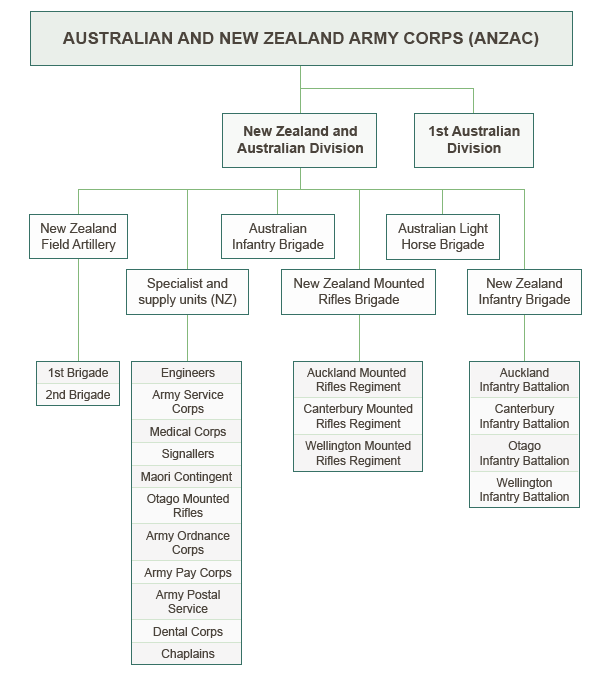
The ANZAC Corps was evacuated from Gallipoli in December 1915, and returned to Egypt to regroup. In early 1916, with the NZEF now able to raise its own division, the Australian and New Zealand forces separated. The bulk of the forces were despatched to France as part of a new New Zealand Division, but most of the mounted riflemen remained in the Middle East with the Australian and New Zealand Mounted Division.
Western Front, 1916-19
In early 1916 the New Zealand authorities had enough reinforcements in Egypt to form a third infantry brigade, which allowed the NZEF to form a full division of around 22,000 men. The New Zealand Division joined the British Expeditionary Force on the Western Front in April 1916.
The shape of the New Zealand Division gradually shifted during its years on the Western Front. Machine-gun companies, trench mortar batteries, entrenching battalions and a pioneer battalion were added to help manage trench warfare conditions between 1916 and 1918.
The most substantial change was the addition of a fourth infantry brigade in March 1917, which briefly pushed the size of the NZEF up to around 26,000 men. The fourth brigade served on the Western Front until it was disbanded in February 1918.
New Zealand Division, 1916
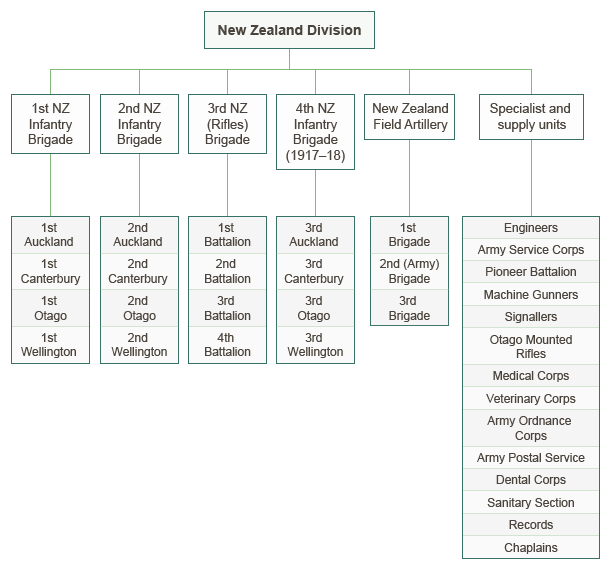
The two infantry brigades were reorganised at the start of 1917 so that the 1st Infantry Brigade consisted of the four North Island battalions, and the 2nd Infantry Brigade the four South Island battalions.
Most of the New Zealand units on the Western Front served together in the New Zealand Division, but a few small specialist unit were attached to other British units. These include the Tunnelling Company, the Cyclists Companies, Light Railways, and at times the 2nd (Army) Field Artillery Brigade and the Otago Mounted Rifles.
The New Zealand Division was supported by a comprehensive administrative network and camp system in England throughout its time on the Western Front. From mid-1916 the main New Zealand base was Sling Camp on Salisbury Plain, where units trained in preparation for despatch to the front. As troop numbers expanded many units were moved to other camps in southern England.
Ill and wounded men evacuated from France were treated in three major New Zealand hospitals in England. Men were typically operated on at Brockenhurst or Walton-on-Thames before being moved to the convalescent hospital at Hornchurch. They either completed their recovery at the New Zealand Command Depot at Codford before being returned to the front, or were sent to the New Zealand Discharge Depot in Torquay to await passage home to New Zealand.
The NZEF also maintained an Infantry and General Base Depot in Étaples, France, where troops were housed on their way to the front, and an Embarkation Camp at Rouen. The New Zealand Stationary Hospital was based in various French centres between 1916 and 1918.
Following the Armistice in November 1918, the New Zealand Division marched into Germany and served in Cologne as part of the army of occupation until March 1919. After that all troops were evacuated to bases in England, and eventually embarked for New Zealand.
Mounteds in the Middle East, 1916-19
The Auckland, Wellington and Canterbury mounted rifles regiments were separated from the main New Zealand forces in the reorganisation of early 1916. It was clear by this time that mounted riflemen had little value in the stationary trench warfare of the Western Front, so the three regiments were retained in the Middle East. There the war remained one of movement, with horsemen attacking each other over open ground.
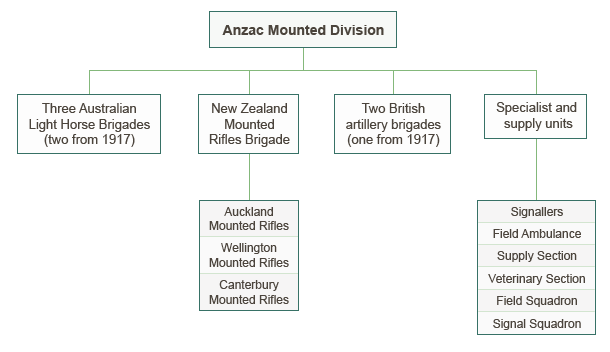
The three New Zealand regiments became part of the Australian and New Zealand Mounted Division, along with three (later two) Australian mounted brigades, two (later one) British artillery brigades, and various support units. (Often described as the ANZAC Mounted Division, this had no connection with the ANZAC Corps, which was now in France) The Australian and New Zealand Mounted Division served as part of the Egyptian Expeditionary Force which fought Ottoman forces in Sinai and Palestine.
II Anzac Corps and XXII Corps, 1916-18
A second Australian and New Zealand Army Corps (II Anzac) created in March 1916 included the newly-formed New Zealand Division. The Otago Mounted Rifles and the New Zealand Cyclist Corps were separate from the New Zealand Division but also within II Anzac Corps.
There they remained until 1 January 1918, when II Anzac Corps was disbanded and its New Zealand units moved to XXII Corps. The New Zealand Division was attached to VII Corps from March 1918, but the other New Zealand units remained part of XXII Corps.
New Zealand units in II Anzac Corps, July 1916–December 1917
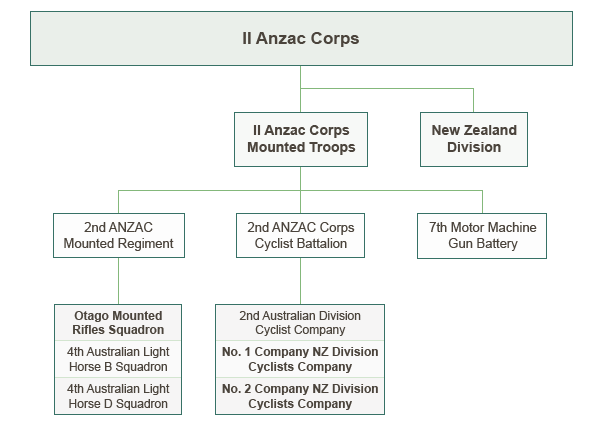
In January 1918 a third New Zealand cyclist company replaced the Australian cyclist company.
New Zealand units in XXII Corps, January–March 1918
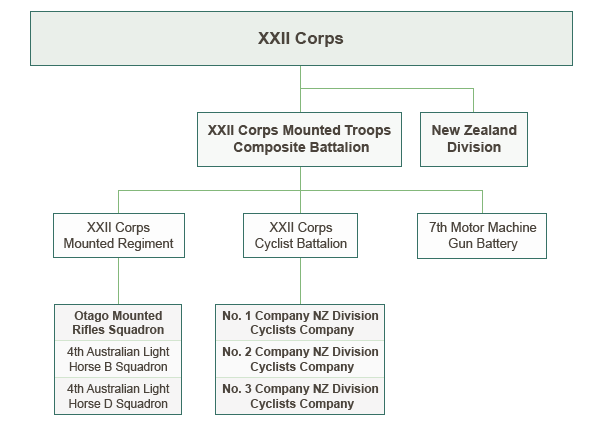
XXII Corps’ Mounted Composite Battalion was reorganised in March 1918 to bring it closer in form to an infantry battalion.
New Zealand units in XXII Corps, March–November 1918
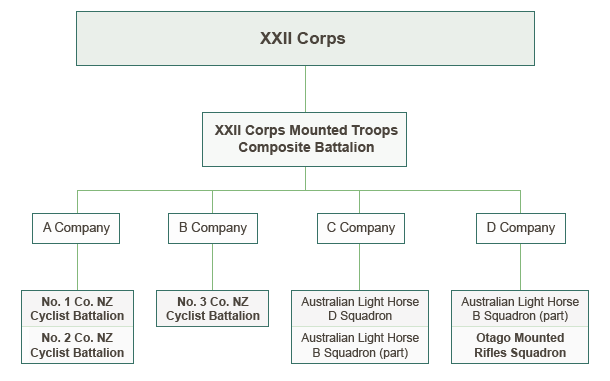
After the Armistice, these units were condensed and combined before being disbanded in March 1919.
Samoan Expeditionary Force
A few days after the war began, the British authorities asked New Zealand to seize German Samoa. The government quickly assembled the Samoan Expeditionary Force (sometimes known as ‘the Advance Party’ of the NZEF) to undertake the operation. The 1413-strong force which left New Zealand on 15 August 1914 comprised a mixture of infantry, artillery, and specialist and supply units.
After German Samoa was taken without incident, the New Zealand forces were converted into a garrison to occupy the islands for the remainder of the war. In April 1915 many of the Samoan Expeditionary Force men were returned to New Zealand, where some re-enlisted for service with the NZEF at Gallipoli. The size of the garrison was set at 223 in December 1915, and enlarged slightly to 234 in August 1916. A total of 2079 men had served in Samoa by the end of the war.



Community contributions